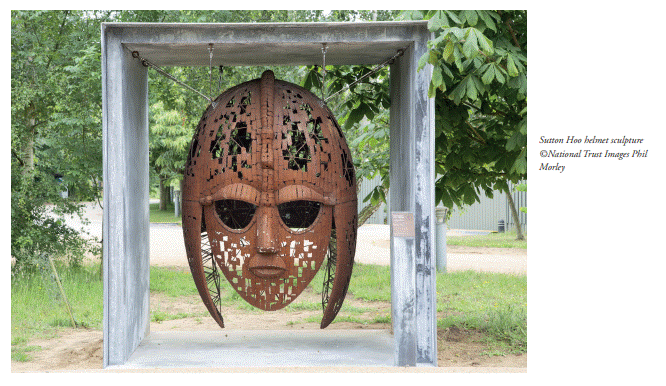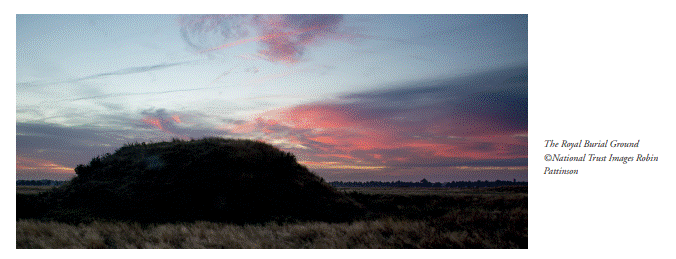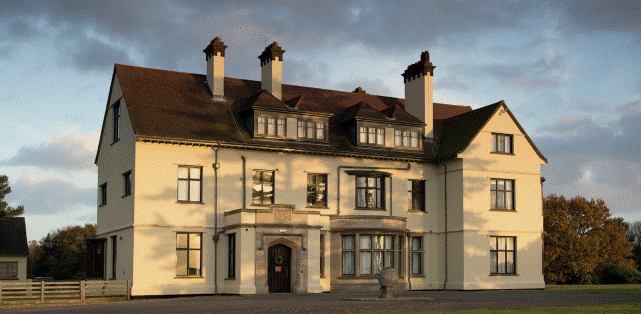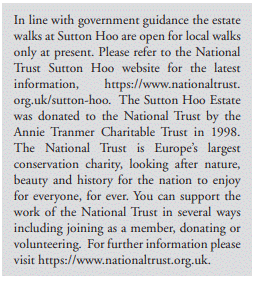The Dig is a new film by Netflix, based on the novel of the same title by John Preston. But do you know the true story of the excavation of the Great Ship Burial at Sutton Hoo? Read on to discover more. The Dig (released on 29th January) is a film by Netflix exploring the story of the excavation of the Great Ship Burial at Sutton Hoo in 1939. The film is based on a novel, also titled The Dig, written by John Preston. Many of the events and characters depicted in both the film and the novel are inspired by real events and real people. Read on to discover the incredible true story, and meet some of the characters involved with one of the greatest archaeological discoveries of all time.
Edith Pretty (1883-1942)
Edith Pretty (Carey Mulligan) was the owner of the Sutton Hoo estate and instigated the first excavations of the Royal Burial Ground. Born into a wealthy family, she spent her youth touring the world and witnessed several excavations which gave her a life-long interest in archaeology and history. The First World War took her to France where she volunteered in a Red Cross hospital. Her husband, Major Frank Pretty, had known Edith (née Dempster) for several years. They married in 1926 and moved to Sutton Hoo in the same year. In 1930 she gave birth to a son, Robert Pretty. Their happiness as a family was short lived as Frank Pretty passed away in 1934, aged 56. In 1937 Edith Pretty turned her attentions towards the curious mounds on her estate, enlisting help from Ipswich Museum. What was found turned out to be one of the greatest archaeological discoveries of all time which she then gifted to the nation.
Basil Brown (1888-1977)
Basil Brown (Ralph Fiennes) was a self-taught archaeologist, born and bred in Suffolk. His father was a farmer, and Basil Brown acquired a great deal of knowledge of the soils and geology of East Anglia whilst working with him. This served him well when he started work as an archaeological contractor for Ipswich Museum in 1935. It was through his connections with Ipswich Museum that Basil Brown came to Sutton Hoo in 1938 to begin the excavation. He retained his passion for archaeology and continued to work on sites after Sutton Hoo, until he suffered a heart attack in 1965 which forced him to retire. His other great passion in life was astronomy. He studied texts from an early age and went on to publish a book, Astronomical Atlases, Maps and Charts: An Historical and General Guide, in 1932.
Robert Pretty (1930-1988)
Robert Pretty (Archie Barnes) was Edith Pretty’s son. Tragically, he was only 4 years old when his father passed away. The excavation was a source of great excitement for young Robert Pretty, who was seen excavating with a toy spade around the site. At the end of the excavation period Edith Pretty commissioned Dutch artist Cor Visser to paint portraits of them both. In his painting, generously donated to the National Trust by his son David Pretty and now on display in Tranmer House, he was depicted clutching a toy ship. The depth of his involvement in the excavations was revealed in 1987 when Professor Martin Carver’s team re-excavated Mound 2. When the team had reached the base of the back-fill from the previous excavation they discovered a pair of roller skates buried in the soil. Robert Pretty was just 12 when Edith Pretty passed away, at which point his aunt Elizabeth (Edith Pretty’s sister) cared for him.

“I’d never heard her name before. The character was so compelling, but diving into her real life was extraordinary. She was so beyond her time as a woman at the beginning of the 20th century. She was well travelled and educated and generous throughout her life”
Carey Mulligan on Edith Pretty
The true story of the excavation of the Great Ship Burial began in July 1937 at the unlikely location of Woodbridge Flower Show. It was here that Edith Pretty, who had long been interested in the burial mounds on her estate, first met with Vincent Redstone, a local historian who wrote to Ipswich Museum. Shortly afterwards Guy Maynard, curator of Ipswich Museum, visited the Sutton Hoo estate and the wheels were set in motion to explore the site, but little did they know that what would eventually be unearthed would completely transform our understanding of the Anglo-Saxon period. In the following spring, arrangements were made between Edith Pretty, Guy Maynard, James Reid Moir (President of Ipswich Museum) and Basil Brown to begin excavating the site. Edith Pretty provided Basil Brown with accommodation and assistants in the form of Bert Fuller and Tom Sawyer who were labourers on the estate.
Between June and August 1938 Basil Brown and his team excavated three mounds (today referred to as Mounds 2, 3 and 4). Within Mound 3, he unearthed the remains of a cremated man, along with a corroded iron axe-head, part of a decorated limestone plaque, fragments of pottery and the lid of a Mediterranean jug. Mound 2 revealed pieces of iron, which he recognised as ship rivets – although having been previously scattered by grave robbers, they did not immediately suggest a ship burial. He also recovered a piece of blue glass, a gilt bronze disc, iron knives and the tip of a sword blade. Mound 4 was the last of the 1938 season, and whilst it had a very shallow pit, and showed signs of having been robbed, careful excavation revealed some tantalising fragments of bronze, high-quality textile and bone. The objects were presented by Edith Pretty to Ipswich Museum where they were placed on display. The British Museum were also informed about the finds and Guy Maynard wrote several articles on them. There was still great intrigue over the contents of the largest mound, so a second season of excavation was arranged to commence on 8th May 1939.
For the 1939 excavations Basil Brown was joined by William Spooner (gamekeeper) and John Jacobs (gardener). Just three days in John Jacobs called out that he had found a piece of iron. Basil Brown rushed over and recognised it as being a ship rivet. Excavation continued and, despite the excitement, he maintained his careful, methodical, approach.

Peggy Piggott (née Preston, 1912-1994)
Peggy Piggott (Lily James), born Cecily Margaret Preston and later Margaret Guido, became involved in archaeology at an early age. She went on to gain a diploma (equivalent to a degree, which women at some universities were excluded from at the time) from the University of Cambridge in 1934 which she followed with a postgraduate diploma from the Institute of Archaeology in 1936. In the same year, she married her first husband, Stuart Piggott. Peggy Piggott became a highly skilled archaeologist and published works on numerous sites spanning the Iron Age and the Bronze Age. Her skills as an excavator made her a natural choice for Charles Phillips’ team assembled to finish the excavation of the Great Ship Burial in 1939 and she was the first of the team to discover gold at the site. Peggy and Stuart Piggott divorced in 1956. She moved to Sicily where she wrote on Italian archaeology and met her second husband, Luigi Guido. In later life she became an expert on glass beads and published several works on the subject.
Charles Phillips (1901-1985)
Charles Phillips (Ken Stott) became involved in the excavation in 1939. He was an experienced archaeologist and a Fellow at Selwyn College, Cambridge. He had been alerted to the work at Sutton Hoo by a former Cambridge University student, Basil Megaw, working at the Manx Museum, who had been contacted by Ipswich Museum enquiring about ship burials. Charles Phillips first visited the site in June and later in July, following meetings between all parties involved in the excavation, he was placed in charge of proceedings. Charles Phillips and Basil Brown maintained a respectful relationship throughout the excavation, although relations were strained between Charles Phillips and Ipswich Museum at times. Through his contacts he assembled a strong team of archaeologists to assist with the dig including the Piggotts, OGS Crawford and WF Grimes. He maintained a strong interest in Sutton Hoo and last visited the site in June 1985 where he was able to witness work being undertaken by Professor Martin Carver.
Stuart Piggott (1910-1996)
Stuart Piggott (Ben Chaplin) was fascinated by archaeology from a young age. He had worked for various organisations and excavated at numerous sites, including Avebury. It was during this time he started to become an expert on prehistoric Wessex. Despite his knowledge, he didn’t formally qualify in the subject until 1936 after studying at the Institute of Archaeology, where he met Peggy Preston. During the Second World War he was posted to India which became a new area of interest and he published works on the archaeology of the country. After returning to Britain, Stuart Piggott continued his career. In 1946 he became the Abercromby Chair in Archaeology at the University of Edinburgh and for several years he was a trustee of The British Museum. In her later years Peggy visited him regularly and they shared the role of President of the Wiltshire Archaeological and Natural History Society until their deaths.

“The film catches her straight out of university and right at the beginning of her incredible journey. She was an archaeologist for almost 60 years and you just have this sense she had a full life and was brave. She achieved so much against all the odds; she’s an inspiration.”
Lily James on Peggy Piggott
Charles Phillips first visited the Sutton Hoo site on 6th June 1939, following the correspondence with Basil Megaw at the Manx Museum. Charles Phillips was astonished by what he saw, suggesting that the sheer size of the ship could mean it was a royal burial. Both Guy Maynard and Charles Phillips contacted the British Museum. Meetings were arranged between Edith Pretty, the British Museum, the Office of Works, Charles Phillips, Ipswich Museum and the Suffolk Institute of Archaeology to discuss how best to continue. It was decided that Charles Phillips should oversee the work, a position he entered in to on 10th July, with Basil Brown assisting him.
The relationship between Charles Phillips and Basil Brown was one of mutual respect. Charles Phillips was complimentary towards the careful way Basil Brown had excavated the ship. As Basil Brown was employed by Edith Pretty, he wisely remained neutral in any disputes that arose and continued to work alongside Charles Phillips and his team. Tensions did however begin to rise between Charles Phillips and Ipswich Museum.
There was some political background to this; both James Reid Moir and Guy Maynard were heavily involved in the Prehistoric Society of East Anglia throughout the 1920s and 30s. Increasingly, members joined from outside East Anglia and they witnessed the transformation of this organisation into the (national) Prehistoric Society with key members including Charles Phillips, the Piggotts and OGS Crawford. These tensions heightened when Charles Phillips assembled his support team of Peggy and Stuart Piggott. Together, the team began to excavate the burial chamber and on 21st July Peggy Piggott unearthed the first items of gold in the form of the two sword pyramids.
As the team continued to excavate more and more gold emerged from the sandy Sutton Hoo soil. Basil Brown even postponed his planned trip home to see his wife, May, in order to stay and watch as the team carefully exposed more items. Naturally, the discovery of such incredible items only served to heighten the importance of the site and security became an issue. The first gold items had been moved from the Royal Burial Ground to Sutton Hoo House by Basil Brown and Edith Pretty under the watchful eye of William Spooner (gamekeeper) armed with his shotgun. Items began to be sent to the British Museum for study and conservation work to commence. Unfortunately, tensions rose again when Guy Maynard visited the site only to discover gold items had already been removed to London and Charles Phillips had not informed him. At this stage Charles Phillips also invited OGS Crawford and WF Grimes to assist with the excavation work. OGS Crawford became one of the first photographers of the excavation and photographed many of the objects before they left the ground.
The elation at the discovery of the finds led Edith Pretty to organise a sherry party with select guests invited to see the ship on Tuesday 25th July. The earth beside the excavation was shaped specially to provide a viewing platform and the police guard was instated to keep a watchful eye on proceedings with PC Ling brought in from Sutton and PC Grimsey from Melton. All had to be careful not to reveal too much information, as the discovery had not yet been reported in the press. Charles Phillips gave a short speech about the ship, only to be drowned out by the roar of a Merlin engine emanating from a Spitfire flying overhead. The threat of war was looming over England at the time. Although no planes ever crashed at Sutton Hoo, late in the Second World War a B-17 Flying Fortress bomber, Little Davy II, plummeted into the River Deben not far from the site. Only two survived.
Relations continued to worsen between Charles Phillips and Ipswich Museum, whose involvement had become greatly restricted. Following rainfall, Edith Pretty had requested that no further visitors could stand on the viewing platform for fear of the sandy soil giving way. Guy Maynard led some guests, including the Lord Lieutenant of Suffolk, on to the platform only to be ordered down by Charles Phillips, humiliating Guy Maynard in the process.
On the 26th July the story started to appear in the press. The team now found themselves under increasing pressure with journalists swarming their homes and offices. Guy Maynard had given the full story to the East Anglian Daily Times along with images, without consulting Charles Phillips. Security was heightened until on 31st July the last van bound for the British Museum left Sutton Hoo, shortly followed by Charles Phillips’ excavation team.
The next team to arrive on site were from The Science Museum. In August they surveyed the fossil of the ship. At the same time arrangements were being made for the treasure trove inquest which would determine who was the legal owner of the objects.
Mercie Lack & Barbara Wagstaff
In the novel and the film, the photographer at Sutton Hoo is the fictional Rory Lomax (Johnny Flynn). The real key photographers of the excavation were Mercie Lack and Barbara Wagstaff. They were teachers and close friends, on holiday in the area, with a keen interest in both archaeology and photography. Between the 8th and 25th August they captured 400 images and an 8mm cine film. Their images were generously given to the National Trust by Mercie Lack’s great nephew, Andrew Lack, and have recently been conserved and digitised.
May Brown (née Oldfield 1897-1983)
Dorothy May Brown (Monica Dolan) first met Basil Brown in Cromer on a day out. At the time she was in service to a family from Norwich who spent their summers on the coast. They married in 1923. She was a great champion for him throughout his career and supported their income with various jobs including cleaning,
looking after local children (they never had children of their own), and writing for the local
press. They regularly exchanged letters whilst he was at Sutton Hoo and she wrote personally
to Edith Pretty thanking her for giving him the opportunity. In recognition of her gift to the nation, Edith Pretty was offered a CBE in December 1940. She declined. For all of those involved, despite only being brought together for a short space of time, Sutton Hoo remained a special highlight throughout the rest of their careers and many of the relationships that they established continued. Sadly, Guy Maynard and Charles Phillips’ relationship did not improve. Charles Phillips avoided Ipswich Museum until Guy Maynard retired in 1952. Basil Brown revisited the site in 1947 and reunited with William Spooner and John Jacobs. Edith Pretty did not live to see the full impact of her gift. She died in 1942.

The other digs
The Dig covers the story of the 1939 excavations but, as remarkable as the excavations that year were, the Royal Burial Ground has been subject to numerous other archaeological campaigns which have helped to improve our understanding of this special landscape, and the world of the Anglo-Saxons.
1965-1971: Following the end of the Second World War the finds were removed from storage and conservation/reconstruction work began. This work led to further questions around the Great Ship Burial, so the decision was taken to re-excavate the area. A team led by Rupert Bruce Mitford (of the British Museum) and Paul Ashbee oversaw this work. The imprint of the ship was exposed once more, having suffered some damage after the Royal Burial Ground had been used as a military training area, and was fully excavated including the area below the imprint of the ship. The massive advances in science made since the war also allowed the team to conduct further analysis of the site.
1983-1992: Whilst much work had been undertaken on the Great Ship Burial large areas of the Royal Burial Ground had not been investigated after Basil Brown’s work was cut short by the Second World War. A much larger programme of excavation commenced in 1983 under the expert eye of Professor Martin Carver. This excavation included the discovery of Mound 17 which contained a young warrior and his horse, Mound 14 which contained the only known high status female burial on the site, and 39 slightly later execution burials which had been preserved in the sand.
2000: Prior to building our Visitor Centre during 2000, the area of another hoo peninsula was investigated by Suffolk County Council archaeology unit. An additional Anglo-Saxon cemetery was revealed, predating the Royal Burial Ground. Archaeologists went on to find 13 cremations and 9 burials in the area excavated, five of which were under small burial mounds. Not quite as grand as the ship burials, these were the graves of residents from a variety of low to relatively high status families. Women had been buried with everyday items including combs, bowls, small knives, shoulder brooches and beads. Spears and shields were found in many of the male graves. Despite their lower status, it’s quite possible that these were the grandparents and great grandparents of East Anglian kings, such as those laid to rest in the Royal Burial Ground many years later.
A Netflix original
As Sutton Hoo is open all year round sadly it wasn’t possible for the Netflix team to undertake any filming on site. With the key story being the excavation of the Great Ship Burial there was naturally a need to show excavation in action, something not possible on the real-life Royal Burial Ground which is a scheduled monument. However, the team at Netflix went to great lengths to capture the magic of the Sutton Hoo landscape in their recreation of the Royal Burial Ground. Several cast members also visited Sutton Hoo to get a feeling of the place and the story. In return a few lucky members of staff and volunteers were invited to visit the film set. The replica artefacts used in the film were of the highest quality, some of them were made by the same craftspeople who made the replica items on display in our exhibition spaces. Whilst no filming took place at Sutton Hoo, several scenes were filmed locally with locations including Butley, Thorpeness and Snape.
The story continues…
Despite the large number of archaeological campaigns undertaken at Sutton Hoo there are still undoubtedly secrets hidden in the soil. Several areas of the Royal Burial Ground have not been excavated. Excavation, although a proven method of exploring the past, is a destructive process and once something has been completely excavated it is gone forever. By leaving some areas undisturbed it not only means there is something for future generations to discover, it also means we can hold off whilst non-invasive techniques develop. Several non-invasive archaeological techniques have already been deployed at Sutton Hoo. Their use reflects just how much new techniques have developed since the first excavations took place.
None of them existed when Basil Brown was working at Sutton Hoo in the 1930s. The most prominent of these are the various forms of archaeological mapping undertaken using geophysics. Surveys using electrical resistance equipment, magnetometry, ground penetrating radar and lidar have all been partially undertaken at Sutton Hoo building up a picture of what lies beneath our feet. As part of our National Lottery Heritage Funded project, Releasing the Sutton Hoo Story, we have been able to purchase our own electrical resistance meter and a dedicated team of volunteers are now surveying further areas of the site with assistance from visitors. Other non-invasive techniques have also been used to inform our understanding of this site. Field walking surveys have been undertaken along with metal detecting surveys of key areas. As landscape archaeology emerged as a discipline in the late 20th century it has expanded the story beyond Sutton Hoo placing it into the wider context of Anglo Saxon England. All these methods are also currently being used to investigate the nearby Anglo-Saxon royal settlement of Rendlesham, as part of the Rendlesham Revealed project, which will further add to our understanding of the Anglo-Saxon kingdom of East Anglia.
Reproduced from Digging the Dirt: the true story behind The Dig by kind permission of the National Trust.


